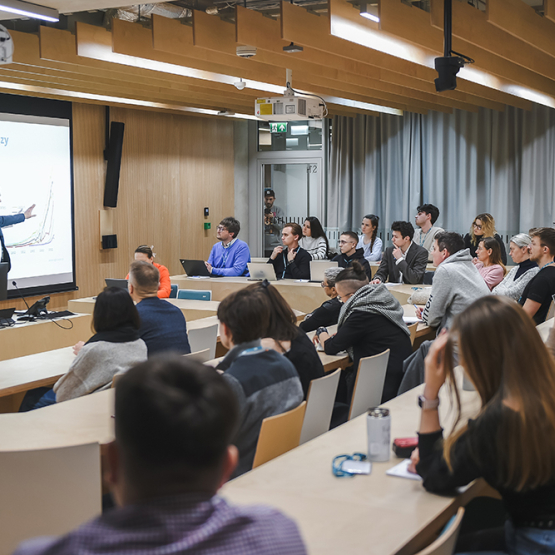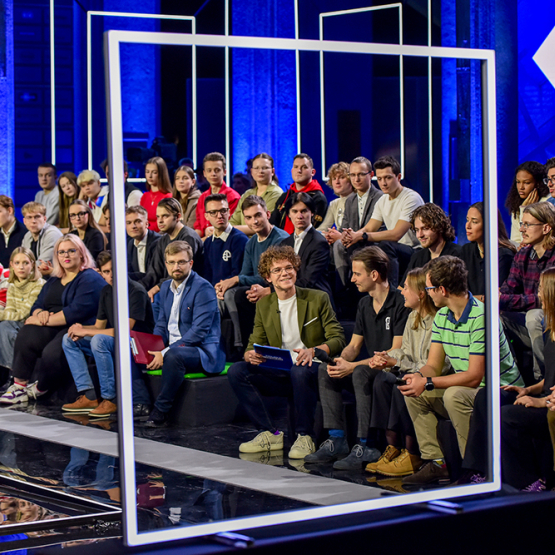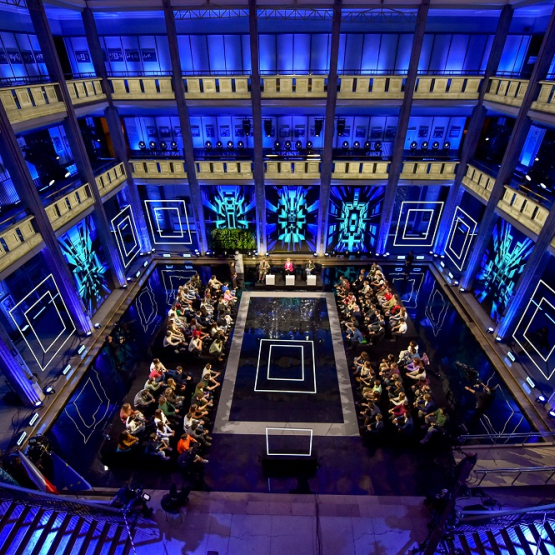
Architect, watercolourist, author of Warsaw murals, including the one presenting “President from SGH” in Mokotów. Winner of the contest for the Warsaw Citizen of the Year. Magdalena Święcicka talks to Tytus Brzozowski.
Magdalena Święcicka: At the end of the year 2022 you unveiled the SGH mural in Mokotów, and already in March 2023 you won the Warsaw Citizen of the Year plebiscite. Over the past 12 months, you’ve accomplished numerous fantastic artistic projects that have garnered great interest from the capital’s residents, but increasingly, you’ve also been doing work for businesses and institutions. You’ve been successful in this field as well. Ten or fifteen years ago, did you expect that an artist, a watercolourist, a painter, a rather niche creator, would gain interest of such a large audience and be so appreciated?
Tytus Brzozowski: Fifteen, or even ten years ago, I was planning entirely different things, and maybe this is an interesting story about how it’s worth trying and seizing opportunities. During the time you’re asking about, I lived in Finland, where I studied and worked. My primary plan was to succeed in architecture, to which I devoted all my time and efforts. My dreams for the more distant future revolved around constructing significant buildings that would change my beloved Warsaw. I wanted to be like Bohdan Pniewski, an architect known and beloved by Warsaw residents, to become a designer who would permanently inscribe himself into the city’s fabric. My immediate plans focused on working in a dream architectural firm, which I achieved shortly afterwards. Upon returning from Finland, I joined the firm JEMS Architekci, and that’s where my career took an unexpected turn. Working with office buildings, large housing estates, or skyscrapers, I was seeking relief in my hobby from my student days – painting. Painting fantastic lands, where my city became the main character, turned out to be a remedy for the stress of working on major investments. Unlike in architecture, here everything depended on me: houses could really fly, trams could emerge directly from buildings, and tenements could stand on long, thin legs above green meadows. After the first exhibition of my paintings and the interest it generated, it became clear that a new, exciting, and entirely unplanned path was emerging before me. Architecture is a vocation and a mission; I could not imagine giving it up. However, working on my own project, in a field that gives me immense satisfaction, absorbed me completely, and I quickly realized that there was no turning back to designing for me. I deeply regretted that the vision of changing Warsaw, of making my mark on the city’s fabric, would likely be inaccessible to me, but the joy of daily work and the sincere, warm emotions I received as feedback were a new quality. It’s probably a cool example of how life can lead us down unexpected paths and how sometimes it’s good to trust intuition.
A few years ago, I attended the opening of your exhibition in Saska Kępa. Crowds came to see it! It was very interesting to listen to your lecture, in which you vividly spoke about your artistic evolution, colours, motifs, and fascination with architecture. That was when I thought: this is it! This is the idea for me. It seems you’re pursuing it very consistently, mural after mural. Have you ever defined the goal of this professional path for yourself? Or maybe there are several?
Setting goals really motivates to act and organizes time. It’s great if the goals include dreams that can be broken down into more down-to-earth, yet more achievable steps. I’m constantly planning various things in the long term, and I also outline goals for the near future.
Working with heart and passion really helps; for me it is quite easy. It just so happened that something I treated as a pleasure or a relaxing addition done in my spare time has become my main occupation. I am fascinated by Warsaw, its tangled history, pervasive nostalgia, and its extraordinary drive. It’s very important for me to convey this in my work.
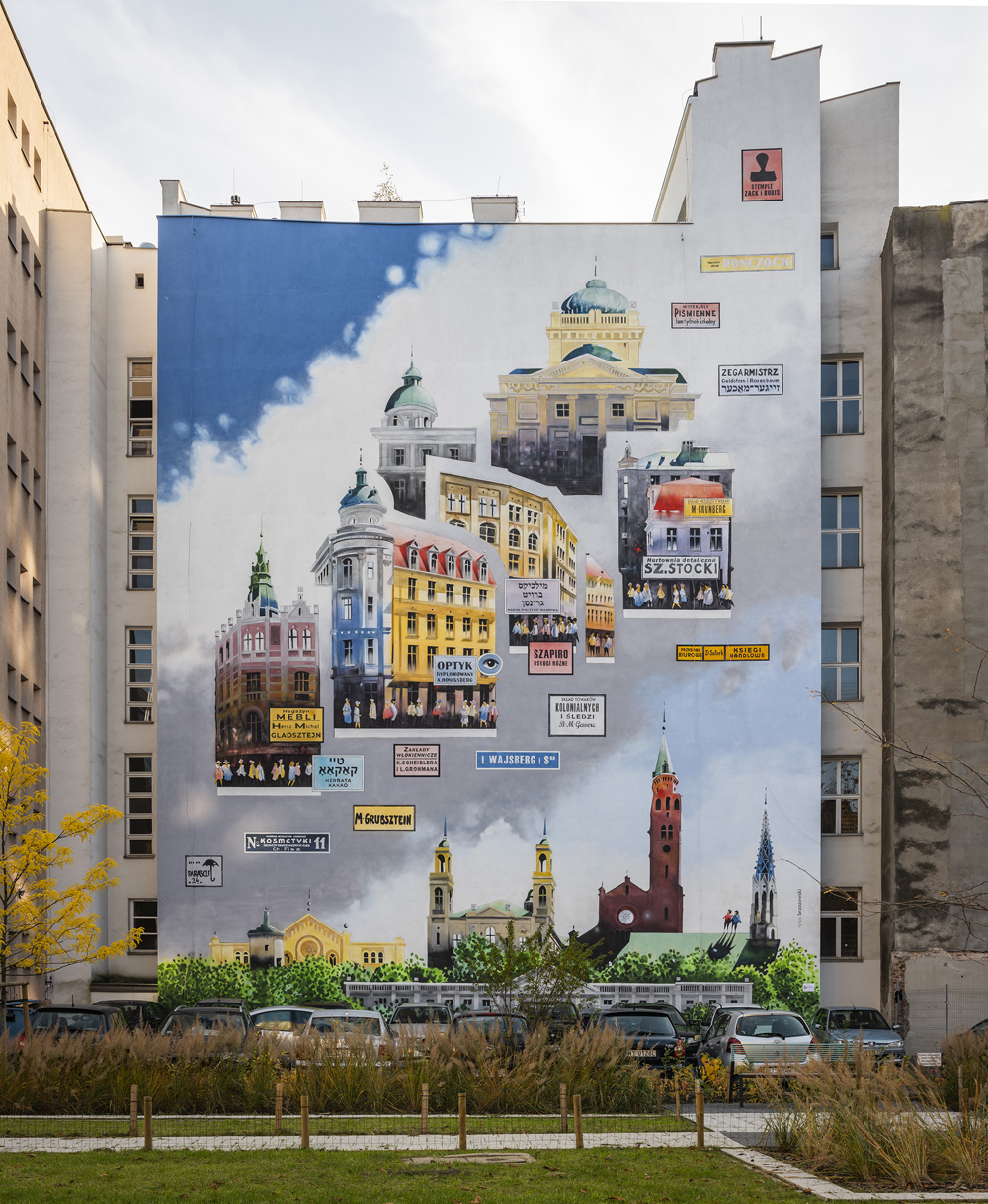
Mural on Próżna Street
Let me go back to your idea of yourself and consistently sticking to its realization. Today, in the age of new media, we would call it “personal brand management.” Since I can remember, you’ve been actively involved in social media, appearing in traditional media, consciously building a community centred around your idea of yourself, or perhaps already – and I wouldn’t hesitate to use this term – a brand. Your communication is characterized by authenticity, spontaneity, but also consistent frequency of publication. How would you define this stage of your professional and media presence? Is it still a “good idea of yourself” or already a conscious management of personal brand?
From the very beginning, I tried to manage my brand as professionally as possible. I think everyone has one. I assumed that the way we’re perceived by others largely depends on what we say about ourselves or how we present ourselves. A significant moment for me was the first exhibition, which took place at SARP on Foksal Street. While organizing this event, I developed a lot of standards that would apply later on. I built a language of my visual identity, established contacts with the media that I still have today. Of course, I was also in social media, where I try to be active all the time. However, I think it’s important to keep a healthy perspective here. Wide reach doesn’t necessarily reflect the value of what we do or success in our field. Social media are fickle and rely increasingly on providing entertainment. Everyone has to consider how much time they want to spend on getting their message across to others, and how much time to spend on actual work.
Grand galas, awards, interviews, and a sense of artistic and professional fulfilment are certainly a source of immense satisfaction and motivation. But what, in your opinion, lies at the foundation of success? Let me guess: hard daily work, maybe even a discipline that we as recipients don’t perceive?
I am m disciplined, I love my work, and I devote a lot of time to it. I used to believe that achieving success required 130 percent commitment (laughs). I think that passion, strong will, and life momentum are very necessary, although lately I’ve been investing more in work-life balance. We all have the same 24 hours to manage.
In the Warsaw Citizen of the Year 2022 contest, you received the first prize “for adding colour, energy, and cultural education to Warsaw through urban murals and world-class paintings.” Undoubtedly, with your murals, you initiated a new era in the city’s architectural landscape several years ago, transforming it from an ugly duckling into a vibrant European capital. Did Titus Brzozowski change Warsaw, or has Warsaw always been likeable, and you simply reminded us of that with your work?
I’ve always loved it! Obviously, I was aware that this wasn’t a simple relationship based on easy infatuations. Building a bond with Warsaw has always required time and some goodwill, but it’s true that the unfair image of the city as Cinderella is fading into oblivion. From the beginning, that’s been my work: saying that Warsaw is great and proving it with colourful, fairy-tale images. I’m glad that more and more people think like me, and the truth is that our city is changing a lot. It’s very special to live in times of such vibrant transformation; witnessing this change into a friendly metropolis is a great experience. I strongly believe and I’m truly convinced that Warsaw won’t slow down.
The title of Warsaw Citizen of the Year has a special meaning for me; it’s an extraordinary distinction. Murals have helped me reach out with my ideas and programme to the people of Warsaw. These works are personally very important to me. I’m an architect who gave up on building, and thanks to murals, I had a chance to make a mark in the city! Wall paintings are becoming Warsaw’s hallmark. They add vibrancy, speak about matters important to us, help to adapt the environment and give it new features. There are tours organised to watch them; even the Warsaw Tourist Organization has issued a guide along the route of my murals.
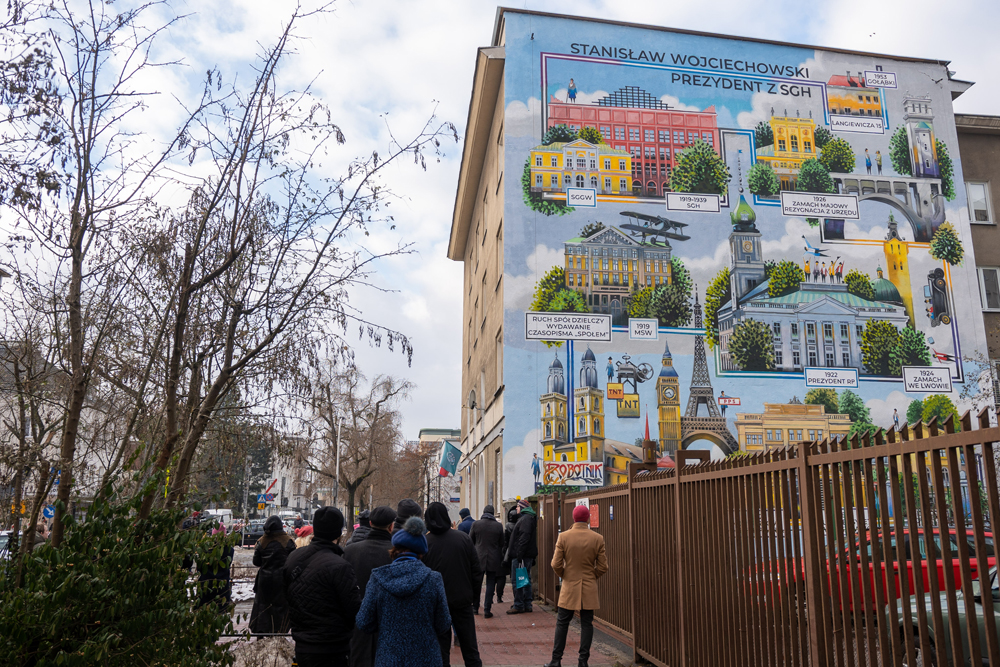
The “President from SGH” mural by Tytus Brzozowski, a recognized architect and painter with ties to Warsaw, was unveiled on 22 December 2022 in front of Building M of the SGH Warsaw School of Economics at 6/8 Madalińskiego Street. The mural commemorates Polish President Stanisław Wojciechowski, who taught at the WSH Higher School of Commerce in Warsaw (later the SGH Warsaw School of Economics) from 1919 to 1939. The work was created on the occasion of the 100th anniversary of Stanisław Wojciechowski’s assumption of the highest office in the state. Stanisław Wojciechowski was the patron of the year 2022 at our university.
Surely, this map won’t miss the mural you made for SGH in December 2022.
The mural on the wall of M building on Madalińskiego Street tells the story of the president from SGH, Stanisław Wojciechowski. He was an extraordinary, albeit somewhat forgotten figure—an activist, conspirator, an agent smuggling weapons and printing machines into Poland. A strong personality with impeccable moral principles. In the project, I managed to show moments from the president’s life such as independence demonstrations, conspiracy, unsuccessful assassination attempt on his life in Lviv, or a key moment for Poland, namely the May Coup, where Wojciechowski opposed Piłsudski during the famous confrontation on Poniatowski Bridge. The mural has also environmental impact: it was made with anti-smog paints, which, thanks to titanium dioxide nanoparticles, under the influence of sunlight and water vapour, break down toxic nitrogen oxides into harmless elements.
This is my first work in Mokotów and in a wonderful location—right next to Puławska Street and Nowy Teatr. There are already several murals on Madalińskiego Street—it’s worth to stroll along them.
Building a bond with Warsaw always required time and some goodwill, but it’s true that the unfair image of the city as Cinderella is fading into oblivion.
Have you ever considered the possibility of visually recreating the original plan of the university campus, authored by Jan Koszczyc Witkiewicz, in a mural? Could it still, over a hundred years after its creation, be an inspiration for builders, future modifiers of the campus?
In my paintings, I use buildings from different parts of the city and different moments in time. I love to recall buildings that no longer exist in Warsaw, and I also enjoy playing “what if,” where I refer to unrealized plans. Pre-war skyscraper projects are particularly intriguing to me.
Warsaw is fortunate to have extraordinary university buildings, and the work of Jan Koszczyc Witkiewicz is absolutely outstanding. The pyramid topping the building is undoubtedly a symbol of the entire district. Both pre-war buildings and the later main building of SGH form a common language and a very beautiful, clear composition. I don’t know anyone who wouldn’t be impressed by the spectacular, bright Parachute Hall (Aula Spadochronowa). Koszczyc Witkiewicz sought a local, Polish language in architecture; SGH campus is a great achievement in his search for traditional, Zakopane-style, Polish motifs. I think studying in a place saturated with history has its great merits; the historical splendour of SGH buildings adds gravity and prestige. Expanding the campus, I would strive for a similar scale and architectural language. If I had to find one element that could easily enhance the qualities of this place, it would be an attractively arranged and prepared green area for leisure and study.
I am talking with an artist, so let’s daydream for a while. How would you imagine a perfect city of the future?
When I was preparing for the architecture exam and we had to draw the city of the future, everyone drew giant skyscrapers with cars flying among them. Today, in the face of climate crisis, a perfect dream city is different. I would rather imagine a green land organized so that the citizens can reach every place easily and quickly, run their errands on foot, spend free time in well-designed public spaces.
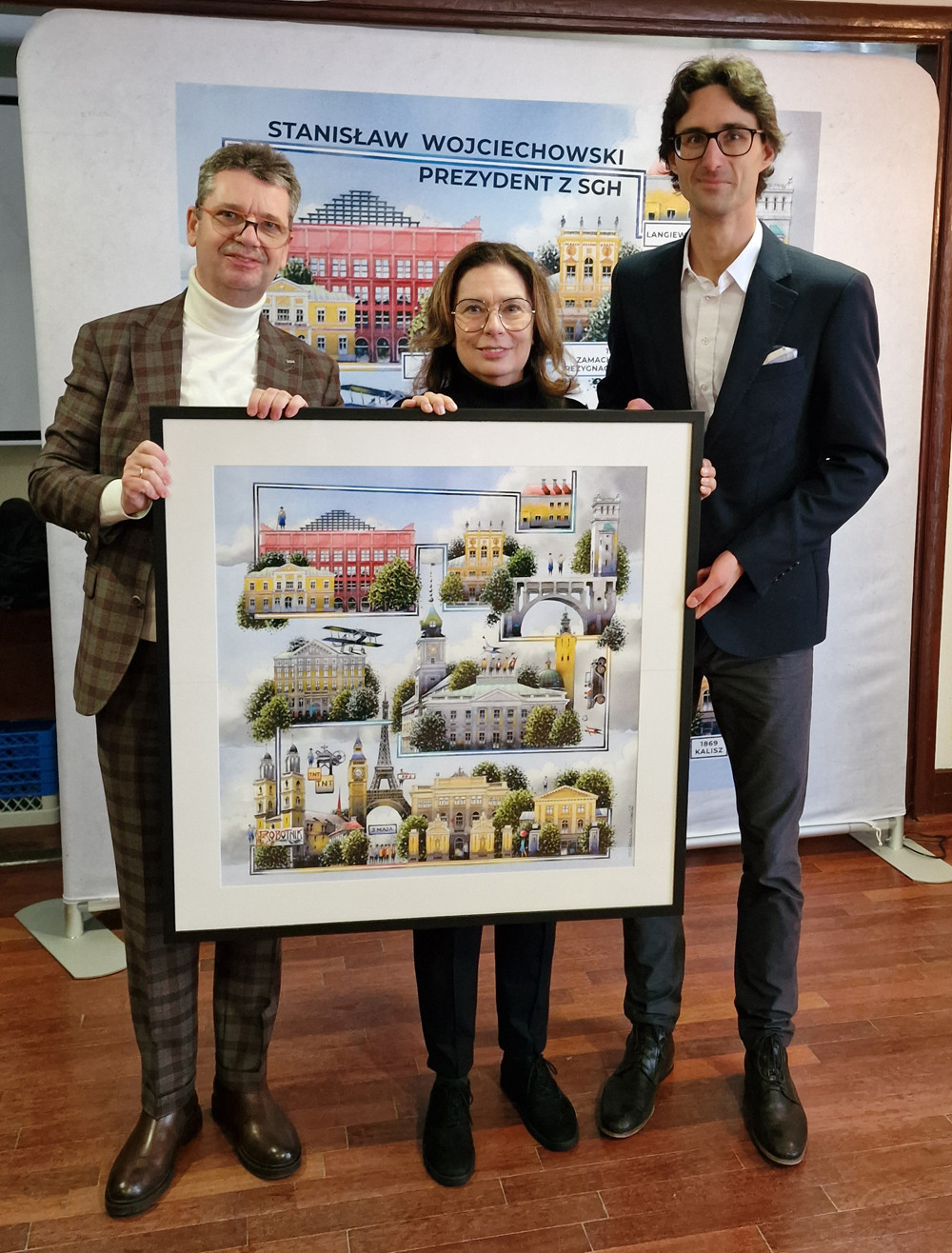
Then-Deputy Marshal of Sejm (lower house of the Polish parliament) Małgorzata Kidawa-Błońska, great-granddaughter of President Wojciechowski, attended the celebrations, which began at SGH with the inauguration of the 2022/2023 academic year. For her part, Kidawa-Błońska thanked the SGH authorities and the SGH staff for commemorating Stanisław Wojciechowski, “for what he did…, to remember his character and, most importantly, the kind of person he was….”
I am also talking to an architect, so let’s come down to earth for a moment and look at things realistically. What should modern cities be like for their residents to make their life quality as good as possible?
Cities must be more friendly and accessible. We need cities with clean air, which don’t turn into heat islands in the summer, boasting efficient transportation, spatial order, and parks. I really wish that Warsaw, a city which is closest to me, would work on its spatial order. In my mind’s eye, I see green squares filled with people, shopping streets, pedestrian promenades, avenues lined with several rows of trees. I dream of even fuller utilization of the great asset, which is the river, curbing the advertising and small architecture chaos, organizing a real city centre, full of services, culture, small squares offering friendly space for leisure and harmonious living.
MAGDALENA ŚWIĘCICKA, former employee of the Press Unit, SGH Rector’s Office
Tytus Brzozowski
fascinated by the soul of the city, recognized author of Warsaw murals. He often juxtaposes building plans and human silhouettes, creating colourful, cheerful scenes bordering on reality and fantasy. His favourite protagonist is the city of Warsaw. Brzozowski’s paintings have been exhibited, among others, during the Season of Polish Culture in Ningbo, China, and on the prestigious ARTLIFE festival in Moscow. They are also used by the Polish Tourist Organization to promote Poland at international fairs. He is the author of the mural “President from SGH,” on Madalińskiego Street in Mokotów, commemorating the centenary of the election of Prof. Stanisław Wojciechowski as Poland’s president. Winner of the contest for the Warsaw Citizen of the Year 2022.

